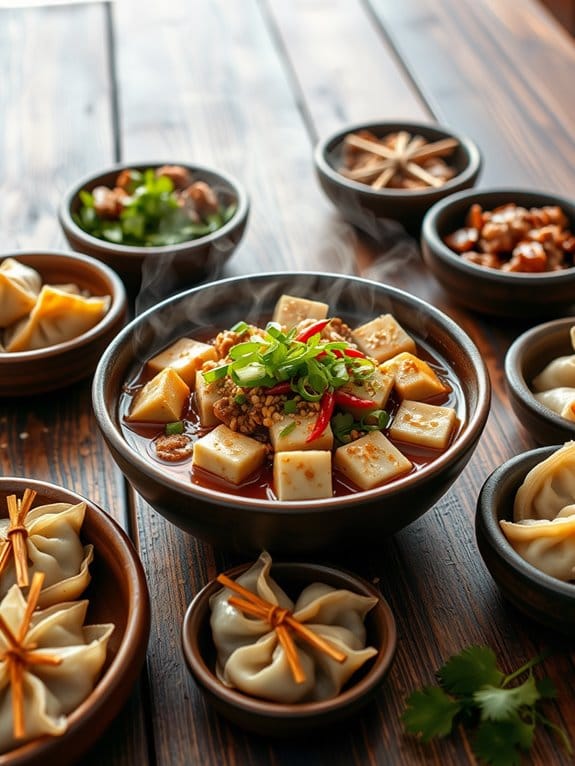There’s something truly magical about cooking with ground pork.
From the rich, savory flavor of Sichuan Dan Dan Noodles to the comforting bite of Cantonese Steamed Pork Buns, each dish tells its own delicious story.
As the garlic and ginger fill your kitchen with mouthwatering aromas, you’ll find yourself enchanted by the vibrant colors of fresh vegetables and spices.
These recipes are not just meals; they’re a chance to create something extraordinary.
Join me as we explore the secrets that make these authentic Chinese ground pork dishes so unforgettable!
Sichuan Dan Dan Noodles
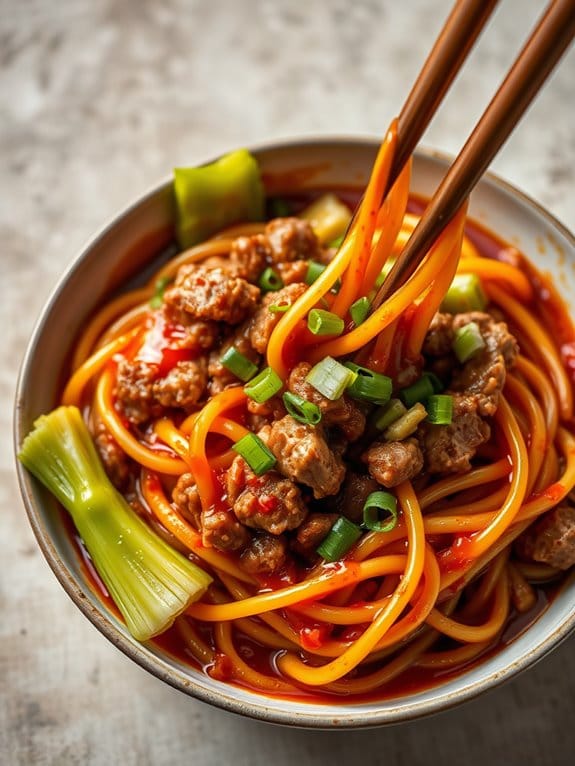
Sichuan Dan Dan Noodles is a popular Chinese dish known for its bold flavors and delightful combination of textures. This dish originates from the Sichuan province and is famous for its spicy, savory, and slightly nutty taste. The name “Dan Dan” refers to the traditional carrying pole that street vendors used to carry baskets of noodles and sauce, bringing this delicious meal to the people.
The key to perfecting this dish lies in balancing the heat of Sichuan peppercorns and chili oil with the savoriness of ground pork and the umami-rich sauce. To create an authentic Sichuan Dan Dan Noodles experience, you’ll need to prepare a rich and spicy sauce that coats the noodles and ground pork perfectly.
The sauce is typically a blend of soy sauce, black vinegar, sesame paste, and chili oil, which together create a complex flavor profile. The noodles are usually served with a topping of seasoned ground pork, scallions, and crisp vegetables such as bok choy. This recipe serves 4-6 people, making it perfect for a family dinner or a gathering with friends.
Ingredients (serving size: 4-6 people):
- 1 pound ground pork
- 1 pound fresh Chinese wheat noodles or thin spaghetti
- 3 tablespoons Sichuan peppercorns
- 1/4 cup Chinese black vinegar
- 1/4 cup soy sauce
- 3 tablespoons sesame paste (or tahini)
- 1/4 cup chili oil (adjust to taste)
- 2 tablespoons vegetable oil
- 4 cloves garlic, minced
- 2 tablespoons ginger, minced
- 6 scallions, chopped
- 1 tablespoon sugar
- 1/2 cup chicken broth
- 1 cup bok choy, chopped
- Salt to taste
Cooking Instructions:
- Prepare the Sauce: In a bowl, whisk together the Chinese black vinegar, soy sauce, sesame paste, chili oil, and sugar until smooth. Adjust the chili oil based on your spice preference.
- Cook the Noodles: In a large pot, bring water to a boil and cook the noodles according to the package instructions. Once cooked, drain and set aside, rinsing with cold water to stop the cooking process.
- Toast the Peppercorns: In a dry skillet over medium heat, toast the Sichuan peppercorns until fragrant. Allow them to cool slightly, then grind them into a coarse powder using a mortar and pestle or spice grinder.
- Cook the Pork: In a large pan, heat the vegetable oil over medium heat. Add the minced garlic and ginger, sautéing until fragrant. Add the ground pork and cook until browned, breaking it apart with a spoon.
- Combine Ingredients: Add the chicken broth to the pan with the pork, followed by the prepared sauce. Stir well and bring to a simmer. Add the chopped bok choy and cook until tender, about 3-5 minutes. Sprinkle in the ground Sichuan peppercorns and mix thoroughly.
- Assemble the Dish: Divide the cooked noodles into serving bowls. Top each portion with the pork sauce mixture. Garnish with chopped scallions and an extra drizzle of chili oil if desired.
Extra Tips:
When making Sichuan Dan Dan Noodles, feel free to adjust the level of spiciness by varying the amount of chili oil and Sichuan peppercorns. If you prefer a creamier texture, increase the sesame paste.
For a more authentic touch, try to source fresh Chinese wheat noodles and Chinese black vinegar, which contribute to the dish’s traditional flavor. If fresh noodles are unavailable, thin spaghetti is a suitable substitute.
To save time, the sauce can be prepared in advance and stored in the refrigerator for up to three days.
Cantonese Steamed Pork Buns
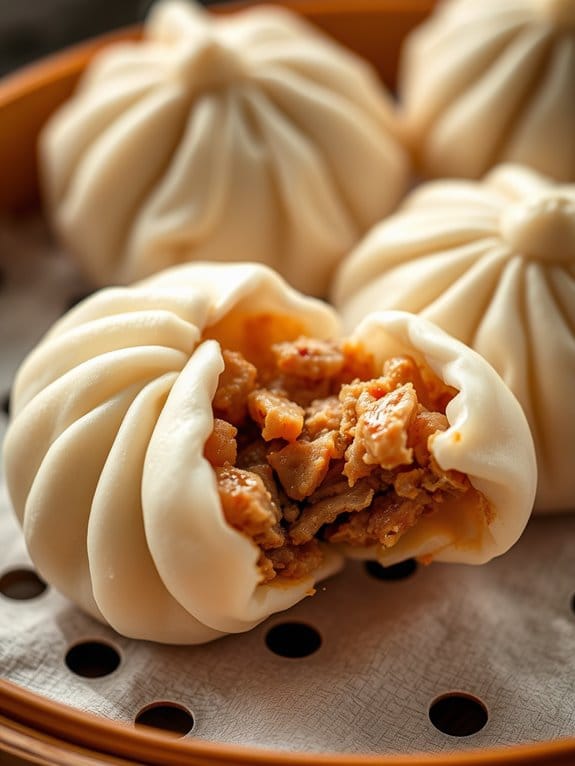
Cantonese Steamed Pork Buns, also known as Char Siu Bao, are a popular dim sum delicacy that combines the fluffy texture of steamed buns with the sweet and savory flavor of barbecued pork filling. These buns are a staple in Cantonese cuisine, cherished for their tender and juicy ground pork filling encased in a soft, pillowy dough. Making these buns at home is a rewarding experience, allowing you to enjoy the authentic flavors of a Chinese teahouse in the comfort of your kitchen.
The process of making Cantonese Steamed Pork Buns involves two main components: the dough and the filling. The dough is made from a mixture of flour, yeast, sugar, and water, which is then left to rise until it doubles in size. The filling is a fragrant combination of ground pork, soy sauce, oyster sauce, sesame oil, and a touch of sugar, creating a deliciously balanced umami taste. Once the dough and filling are prepared, they’re assembled into individual buns and steamed until perfectly cooked.
Ingredients (Serves 4-6):
Dough:
- 3 cups all-purpose flour
- 1 packet (2 1/4 teaspoons) active dry yeast
- 1/4 cup sugar
- 1 cup warm water
- 2 tablespoons vegetable oil
- 1/4 teaspoon salt
Filling:
- 500g ground pork
- 2 tablespoons soy sauce
- 1 tablespoon oyster sauce
- 1 tablespoon sugar
- 1 tablespoon cornstarch
- 1 tablespoon sesame oil
- 1/4 cup chopped green onions
- 1 tablespoon minced garlic
- 1 tablespoon rice wine (optional)
Cooking Instructions:
1. Prepare the Dough: In a large mixing bowl, dissolve the sugar in warm water. Sprinkle the yeast over the top and let it sit for about 10 minutes, or until it becomes frothy. Add the vegetable oil and salt to the yeast mixture. Gradually add the flour, stirring until a dough begins to form. Knead the dough on a lightly floured surface for about 10 minutes until smooth and elastic.
Place the dough in a lightly oiled bowl, cover it with a damp cloth, and let it rise in a warm place for about 1-2 hours, until doubled in size.
2. Make the Filling: While the dough is rising, prepare the filling. In a medium bowl, combine the ground pork, soy sauce, oyster sauce, sugar, cornstarch, sesame oil, green onions, garlic, and rice wine. Mix thoroughly until all ingredients are well incorporated. Cover and refrigerate until ready to use.
3. Assemble the Buns: Once the dough has risen, punch it down and divide it into 12 equal portions. Roll each portion into a ball and then flatten it into a disk. Place a tablespoon of the pork filling in the center of each disk. Gather the edges of the dough and pleat them together over the filling, pinching to seal securely at the top.
4. Steam the Buns: Prepare a steamer by lining it with parchment paper or lightly greasing it to prevent sticking. Place the buns in the steamer, leaving enough space between them as they’ll expand during cooking. Steam over boiling water for about 15-20 minutes, or until the buns are fluffy and the filling is cooked through.
5. Serve: Once steamed, remove the buns from the steamer and let them cool slightly before serving. Enjoy them warm for the best texture and flavor.
Extra Tips:
For the best results, confirm that your yeast is fresh and active by testing it in water with sugar before proceeding with the dough. When kneading the dough, it should feel smooth and elastic; avoid adding too much flour, as this can make the buns dense.
Make sure the filling is well-chilled before assembling the buns to make it easier to handle and guarantee even cooking. If you prefer a sweeter filling, you can adjust the sugar to taste. Additionally, you can freeze uncooked buns after assembling them; just thaw and steam them as needed.
Hunan Spicy Pork Stir-Fry

Hunan Spicy Pork Stir-Fry is a classic dish from the Hunan province of China known for its bold and vibrant flavors. This dish combines the aromatic and spicy essence of Hunan cuisine with tender ground pork, creating a delightful stir-fry that’s both savory and spicy. The use of fresh ingredients such as garlic, ginger, and chili peppers brings out the authentic taste of the region, while soy sauce and rice vinegar add depth and complexity to the overall flavor profile.
Cooking Hunan Spicy Pork Stir-Fry is an excellent way to enjoy an authentic Chinese meal at home. It’s a quick and easy recipe that can be prepared in under 30 minutes, making it perfect for busy weeknight dinners. While the heat from the chili peppers can be adjusted to suit your personal taste, this dish is designed to pack a punch, so don’t shy away from embracing the spice.
Serve this stir-fry with steamed rice to balance out the heat and provide a complete and satisfying meal for 4-6 people.
Ingredients:
- 1 pound ground pork
- 2 tablespoons vegetable oil
- 3 garlic cloves, minced
- 1-inch piece of ginger, minced
- 2-3 fresh red chili peppers, sliced
- 1 red bell pepper, sliced
- 2 tablespoons soy sauce
- 1 tablespoon rice vinegar
- 1 tablespoon hoisin sauce
- 1 teaspoon sugar
- 1/2 teaspoon ground Sichuan peppercorns
- 2 green onions, chopped
- Salt and pepper to taste
- Cooked white rice for serving
Cooking Instructions:
1. Prepare the Ingredients:
Begin by gathering and preparing all your ingredients. Mince the garlic and ginger, slice the chili peppers and red bell pepper, and chop the green onions. This will guarantee a smooth cooking process.
2. Cook the Ground Pork:
Heat 1 tablespoon of vegetable oil in a large skillet or wok over medium-high heat. Add the ground pork and cook until browned and cooked through, breaking it apart with a spatula as it cooks. Once done, remove the pork from the skillet and set aside.
3. Sauté Aromatics:
In the same skillet, add the remaining tablespoon of vegetable oil. Add the minced garlic, ginger, and sliced chili peppers. Stir-fry for about 1-2 minutes until they’re fragrant.
4. Add Vegetables:
Add the sliced red bell pepper to the skillet and stir-fry for another 2-3 minutes until the bell pepper begins to soften.
5. Combine Ingredients:
Return the cooked pork to the skillet. Add the soy sauce, rice vinegar, hoisin sauce, sugar, and ground Sichuan peppercorns. Stir well to combine all the ingredients and coat the pork in the sauce.
6. Final Touches:
Add the chopped green onions to the skillet. Stir everything together, and cook for an additional minute. Taste and adjust with salt and pepper as needed.
7. Serve:
Serve the Hunan Spicy Pork Stir-Fry hot over a bed of cooked white rice, allowing the flavors to meld together.
Extra Tips:
When making Hunan Spicy Pork Stir-Fry, feel free to adjust the number of chili peppers based on your spice preference. If you prefer a milder dish, remove the seeds from the peppers or use fewer chilies. For those who enjoy extra heat, consider adding dried red chili flakes or more fresh chilies.
Additionally, for an authentic touch, you can replace the vegetable oil with peanut oil for a nutty flavor. Remember to keep your ingredients moving in the skillet to prevent burning and guarantee even cooking. Enjoy experimenting with this dish to make it your own!
Shanghai Lion’s Head Meatballs

Shanghai Lion’s Head Meatballs are a traditional Chinese delicacy, renowned for their succulent texture and rich flavors. Named for their resemblance to a lion’s mane, these large, savory meatballs are a staple of Shanghainese cuisine. The dish is typically made with ground pork, combined with a variety of spices and seasonings, then gently simmered to perfection.
The meatballs are often served with a light broth or sauce, which enhances their tender juiciness and infuses them with aromatic flavors. This dish is perfect for family gatherings or festive occasions, as it can be prepared in advance and easily scaled up to feed a larger group.
The key to achieving the ideal texture lies in the balance of fat and lean meat, as well as in the gentle handling of the mixture to maintain its integrity. Paired with steamed rice or noodles, Shanghai Lion’s Head Meatballs make for a comforting and satisfying meal that showcases the depth and complexity of Chinese culinary traditions.
Ingredients for 4-6 servings:
- 1 pound ground pork (preferably with a 70/30 lean-to-fat ratio)
- 2 tablespoons soy sauce
- 1 tablespoon Shaoxing wine (or dry sherry)
- 1 teaspoon sesame oil
- 1 tablespoon cornstarch
- 1 egg
- 3 green onions, finely chopped
- 1 tablespoon grated ginger
- 2 teaspoons sugar
- Salt and white pepper to taste
- 1 tablespoon vegetable oil
- 1 cup chicken broth
- 6-8 large napa cabbage leaves
Cooking Instructions:
- Prepare the Pork Mixture: In a large mixing bowl, combine the ground pork, soy sauce, Shaoxing wine, sesame oil, cornstarch, egg, green onions, ginger, sugar, salt, and white pepper. Mix thoroughly until all ingredients are well incorporated. The mixture should be sticky and cohesive.
- Shape the Meatballs: With wet hands, divide the pork mixture into 4-6 portions, depending on the desired size. Gently shape each portion into a large meatball, handling the mixture carefully to avoid compacting it too much, which could make the meatballs dense.
- Brown the Meatballs: In a large skillet or wok, heat the vegetable oil over medium heat. Add the meatballs and gently brown them on all sides, turning carefully to maintain their shape. This should take about 5-7 minutes. Remove the meatballs and set aside.
- Prepare the Simmering Broth: In the same skillet, add the chicken broth and bring it to a simmer. Arrange the napa cabbage leaves at the bottom of the skillet, creating a bed for the meatballs.
- Simmer the Meatballs: Return the browned meatballs to the skillet, placing them on top of the cabbage leaves. Cover and simmer on low heat for 30-40 minutes, allowing the flavors to meld and the meatballs to cook through.
- Serve: Carefully remove the meatballs and cabbage leaves from the skillet, and serve them in a shallow bowl. Ladle some of the broth over the top for additional flavor.
Extra Tips:
When preparing Shanghai Lion’s Head Meatballs, it’s crucial to use a ground pork mixture with a good balance of lean meat and fat for the best texture. If possible, ask your butcher for a custom grind or grind your own pork shoulder or belly at home.
Additionally, be gentle when shaping the meatballs to keep them light and tender. If you find the mixture too sticky to handle, wetting your hands with water can help. Finally, adjust the seasoning to your taste, and remember that the simmering process will enhance the flavors, so don’t over-season initially.
Beijing Zha Jiang Mian

Beijing Zha Jiang Mian is a classic Chinese noodle dish that’s cherished for its rich, savory flavors and comforting textures. The name “Zha Jiang Mian” translates to “fried sauce noodles,” which highlights the dish’s key component: the robust, fermented soybean paste sauce that’s paired with ground pork.
Originating from Beijing, this dish has gained popularity across China and internationally, becoming a favorite for its simplicity and depth of flavor. Traditionally, the dish is served with thick wheat noodles accompanied by a variety of fresh, crunchy vegetables like cucumber and bean sprouts, which complement the hearty, umami-rich meat sauce.
Preparing Beijing Zha Jiang Mian at home brings the authentic taste of Chinese street food into your kitchen. The dish is surprisingly straightforward to make, requiring only a few essential ingredients that come together in a flavorful symphony.
The rich, savory sauce clings to the noodles, creating a satisfying meal that’s both filling and flavorful. For a serving size of 4-6 people, the following ingredients and step-by-step instructions will guide you through the process of making this beloved dish from scratch.
Ingredients:
- 500g thick wheat noodles
- 300g ground pork
- 1 cup fermented soybean paste (Doubanjiang)
- 2 tablespoons soy sauce
- 1 tablespoon Shaoxing wine
- 1 tablespoon sugar
- 2 tablespoons vegetable oil
- 3 cloves garlic, minced
- 1 tablespoon ginger, minced
- 1 cup chicken or vegetable broth
- 1 cucumber, julienned
- 100g bean sprouts
- 2 scallions, finely chopped
- Salt and pepper to taste
Cooking Instructions:
- Prepare the Noodles: Begin by cooking the thick wheat noodles according to the package instructions. Once cooked, drain and rinse them under cold water to stop the cooking process. Set them aside in a large bowl.
- Create the Sauce Base: In a large pan or wok, heat the vegetable oil over medium heat. Add the minced garlic and ginger, stirring until fragrant. This usually takes about 30 seconds to 1 minute.
- Cook the Ground Pork: Add the ground pork to the pan, breaking it apart with a wooden spoon. Cook until the pork is browned and no longer pink, about 5-7 minutes. Season with a pinch of salt and pepper.
- Add the Sauce Ingredients: Stir in the fermented soybean paste, soy sauce, Shaoxing wine, and sugar. Mix well to combine all the ingredients and cook for another 2 minutes to allow the flavors to meld.
- Simmer with Broth: Pour in the chicken or vegetable broth and bring the mixture to a simmer. Lower the heat and let it cook for about 10 minutes until the sauce thickens slightly and the flavors intensify.
- Prepare the Vegetables: While the sauce is simmering, prepare the fresh vegetables. Julienne the cucumber and rinse the bean sprouts thoroughly. Chop the scallions finely.
- Assemble the Dish: To serve, place a portion of noodles in a bowl. Top with a generous amount of the pork sauce, then garnish with julienned cucumber, bean sprouts, and chopped scallions.
- Mix and Serve: Encourage diners to mix the noodles, sauce, and garnishes thoroughly to guarantee each bite is flavorful. Serve immediately.
Extra Tips:
To enhance the flavor of the Beijing Zha Jiang Mian, consider using homemade noodles if you have the time and resources. The texture of fresh noodles can greatly elevate the dish.
Additionally, adjust the seasoning to your taste; some prefer a sweeter sauce, while others might like it spicier. If you enjoy a bit of heat, consider adding a dash of chili oil or fresh chilies to the sauce.
Finally, verify the noodles are well drained before serving to prevent them from becoming soggy from excess water.
Fujian Pork and Cabbage Dumplings

Fujian Pork and Cabbage Dumplings are a traditional Chinese delicacy that beautifully combines a savory pork filling with the crisp freshness of cabbage, all encased in a tender dumpling wrapper. This dish hails from the Fujian province, known for its light and flavorful cuisine. The dumplings are versatile and can be steamed, boiled, or pan-fried, making them a beloved staple in Chinese households. The combination of ground pork, cabbage, and aromatic seasonings creates a juicy and flavorful filling that’s irresistible to dumpling enthusiasts.
Making Fujian Pork and Cabbage Dumplings from scratch can be a delightful culinary adventure. The process involves preparing the filling, assembling the dumplings, and then cooking them to perfection. While it may seem intimidating at first, with a little practice, you’ll be able to create these delicious dumplings with ease. This recipe is perfect for a family meal or a gathering with friends, serving between 4 to 6 people.
Let’s plunge into the ingredients and the step-by-step process to make these delectable dumplings.
Ingredients (Serving Size: 4-6 people):
- 1 pound ground pork
- 2 cups finely chopped Napa cabbage
- 2 tablespoons soy sauce
- 1 tablespoon sesame oil
- 2 teaspoons ginger, minced
- 2 cloves garlic, minced
- 1/4 cup green onions, finely chopped
- 1 tablespoon Shaoxing wine (or dry sherry)
- 1 teaspoon sugar
- 1/2 teaspoon white pepper
- 1 pack round dumpling wrappers (about 50 pieces)
- 1 tablespoon vegetable oil (for pan-frying)
- Water (for steaming or boiling)
- Dipping sauce (soy sauce, vinegar, and chili oil to taste)
Cooking Instructions:
1. Prepare the Filling: In a large mixing bowl, combine the ground pork, chopped Napa cabbage, soy sauce, sesame oil, ginger, garlic, green onions, Shaoxing wine, sugar, and white pepper. Mix thoroughly until all the ingredients are well integrated. Let the mixture sit for about 15 minutes to allow the flavors to meld.
2. Assemble the Dumplings: Place a dumpling wrapper on a flat surface. Add about 1 tablespoon of the filling to the center of the wrapper. Moisten the edges of the wrapper with a little water, fold it in half, and press to seal. You can pleat the edges to create a decorative pattern if desired. Repeat this process until all the filling and wrappers are used.
3. Cook the Dumplings: Choose your preferred cooking method:
- Steaming: Arrange the dumplings in a steamer lined with cabbage leaves or parchment paper to prevent sticking. Steam over boiling water for about 12-15 minutes.
- Boiling: Bring a pot of water to a boil. Add the dumplings in batches to avoid overcrowding. Boil for about 8-10 minutes, or until the dumplings float to the surface and the filling is cooked through.
- Pan-Frying: Heat 1 tablespoon of vegetable oil in a non-stick skillet over medium heat. Place the dumplings in the skillet and cook for 2-3 minutes until the bottoms turn golden brown. Add 1/4 cup of water to the skillet, cover with a lid, and steam for another 5-7 minutes, or until the water evaporates and the dumplings are cooked through.
4. Serve: Transfer the cooked dumplings to a serving plate. Serve hot with a dipping sauce made of soy sauce, vinegar, and chili oil.
Extra Tips:
When preparing the filling, make sure to squeeze out excess moisture from the chopped cabbage to prevent the dumplings from becoming soggy.
If you’re new to pleating dumplings, practice folding a few without worrying about perfection—the taste will still be delicious!
If you have extra dumplings, they can be frozen uncooked and cooked directly from frozen, adding a few extra minutes to the cooking time.
Enjoy experimenting with different cooking methods to find your favorite way to enjoy these delightful dumplings.
Yunnan Minced Pork With Mint

Yunnan Minced Pork With Mint is a flavorful dish that brings together the freshness of mint and the richness of minced pork, creating a harmonious blend of savory and aromatic flavors. This dish hails from the Yunnan province in China, where the cuisine is known for its bold flavors and use of fresh herbs. The combination of tender minced pork, vibrant mint leaves, and a hint of spice makes this dish a delightful addition to any meal.
It’s perfect for those who enjoy a balance of invigorating and hearty elements in their food. This dish isn’t only delicious but also simple to prepare, making it an excellent choice for both weeknight dinners and special occasions. The key to its unique flavor lies in the use of fresh ingredients and the careful layering of flavors, starting with the marination of the pork and ending with the addition of fresh mint.
The cooking process is straightforward, allowing the natural flavors of the ingredients to shine through. Serve it over rice or noodles to soak up the savory sauce, and enjoy the burst of flavors in every bite.
Ingredients (Serves 4-6):
- 500 grams of ground pork
- 1 cup of fresh mint leaves, roughly chopped
- 2 tablespoons of vegetable oil
- 4 cloves of garlic, minced
- 1-inch piece of ginger, grated
- 2 tablespoons of soy sauce
- 1 tablespoon of oyster sauce
- 1 tablespoon of rice wine or dry sherry
- 1 teaspoon of sugar
- 1 teaspoon of chili flakes (optional)
- Salt and pepper to taste
- 2 green onions, sliced
- 1 tablespoon of sesame oil
Cooking Instructions:
- Marinate the Pork: In a mixing bowl, combine the ground pork with soy sauce, oyster sauce, rice wine, sugar, and a pinch of salt and pepper. Mix well and let it marinate for at least 15 minutes to allow the flavors to infuse.
- Prepare the Aromatics: While the pork is marinating, prepare the garlic and ginger by mincing and grating them, respectively. Also, chop the mint leaves and slice the green onions, setting them aside for later use.
- Cook the Pork: Heat the vegetable oil in a large skillet or wok over medium-high heat. Add the minced garlic and grated ginger to the skillet, stirring frequently until fragrant, about 1 minute.
- Add the Pork: Add the marinated pork to the skillet, breaking it up with a wooden spoon. Cook the pork until it’s browned and cooked through, about 5-7 minutes.
- Season the Dish: Add the chili flakes (if using) and adjust the seasoning with additional salt and pepper if needed. Stir in the sesame oil for added flavor.
- Incorporate Mint and Green Onions: Finally, add the chopped mint leaves and sliced green onions to the skillet. Stir well to combine, allowing the mint to slightly wilt while retaining its vibrant color.
- Serve: Transfer the Yunnan Minced Pork With Mint to a serving dish and enjoy it hot, paired with steamed rice or noodles.
Extra Tips:
When cooking Yunnan Minced Pork With Mint, it’s crucial to use fresh mint leaves to capture the authentic aroma and flavor of the dish. If you prefer a spicier version, you can adjust the amount of chili flakes to your taste or add fresh chili peppers.
Be certain not to overcook the mint; it should be added at the last minute to retain its bright green color and fresh taste. For additional texture, consider topping the dish with lightly toasted sesame seeds before serving.
Taiwanese Braised Pork Rice

Taiwanese Braised Pork Rice, also known as Lu Rou Fan, is a comforting and savory dish that’s a staple in Taiwanese cuisine. This dish features tender, slow-braised ground pork that’s simmered in a rich, aromatic sauce and served over steamed rice. The combination of soy sauce, five-spice powder, and other fragrant ingredients creates a deep, umami-rich flavor that’s both satisfying and incredibly moreish.
Traditionally served in households and local eateries across Taiwan, this dish is beloved for its simplicity and heartwarming taste.
The preparation of Taiwanese Braised Pork Rice involves gently simmering ground pork with onions, garlic, and a blend of spices until everything melds together beautifully. The slow cooking process allows the flavors to develop fully, resulting in a dish that’s both flavorful and comforting. Perfect for a family meal or a gathering with friends, this dish is sure to be a hit with anyone who loves authentic Taiwanese cuisine.
Below is a recipe that serves 4-6 people, complete with a list of ingredients and step-by-step instructions.
Ingredients:
- 1 lb ground pork
- 2 tablespoons vegetable oil
- 1 large onion, finely chopped
- 3 cloves garlic, minced
- 2 tablespoons soy sauce
- 2 tablespoons dark soy sauce
- 1 tablespoon oyster sauce
- 1 tablespoon rice wine (or Shaoxing wine)
- 1/2 teaspoon five-spice powder
- 1 tablespoon sugar
- 2 cups water
- 2 hard-boiled eggs (optional)
- Steamed white rice, for serving
- Chopped scallions, for garnish
- Pickled mustard greens, for garnish (optional)
Cooking Instructions:
- Prepare the Ingredients: Begin by gathering all the ingredients. Chop the onion finely and mince the garlic to make sure they cook evenly and release their full flavors.
- Brown the Pork: In a large pan or wok, heat the vegetable oil over medium heat. Add the ground pork and cook until it’s browned and crumbles easily. This should take about 5-7 minutes. Stir occasionally to guarantee even cooking.
- Sauté Onions and Garlic: Once the pork is browned, add the chopped onion and minced garlic to the pan. Cook until the onion is translucent and the garlic is fragrant, about 3-4 minutes.
- Add Seasonings: Stir in the soy sauce, dark soy sauce, oyster sauce, rice wine, five-spice powder, and sugar. Mix well to coat the pork and onions with the sauce.
- Simmer the Mixture: Pour in the water and bring the mixture to a boil. Once boiling, reduce the heat to low, cover, and let it simmer for 30-40 minutes. This will allow the flavors to meld and the pork to become tender.
- Prepare the Eggs (Optional): If using, peel the hard-boiled eggs and add them to the pan during the final 15 minutes of simmering, allowing them to soak up the flavors of the sauce.
- Serve: Once the pork is tender and the sauce has thickened, remove from heat. Serve over steamed white rice, garnishing with chopped scallions and pickled mustard greens if desired.
Extra Tips: For an even deeper flavor, you can prepare the braised pork a day in advance and refrigerate it overnight. Allowing the flavors to marry overnight enhances the taste.
If you prefer a spicier variant, add a pinch of chili flakes or a dash of chili oil during the simmering process. Always adjust the seasoning to your taste, adding a bit more soy sauce or sugar if needed. Finally, verify the rice is freshly steamed to complement the dish perfectly.
Xi’an Spicy Pork Soup
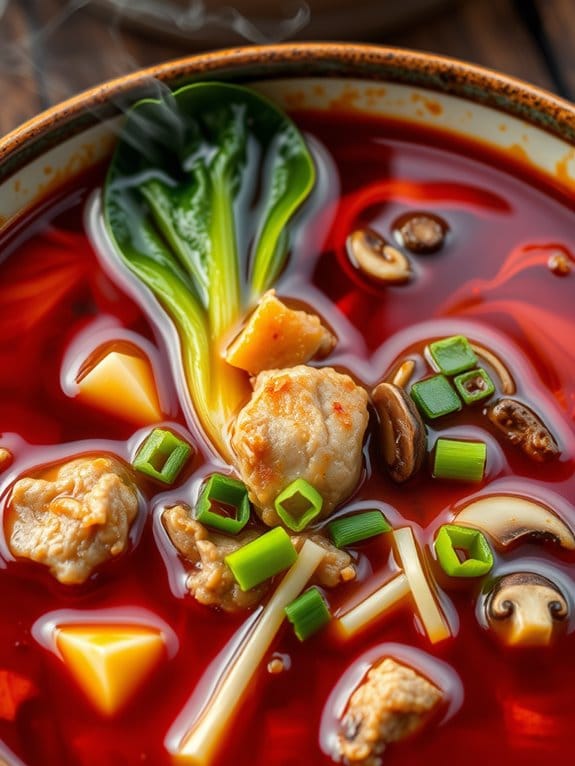
Xi’an Spicy Pork Soup is a traditional Chinese dish originating from Xi’an, a city known for its rich culinary heritage. This flavorful soup is a harmonious blend of savory ground pork, aromatic spices, and a hint of heat that will warm your soul. The soup is perfect for a chilly evening or when you’re craving something comforting yet bold.
The richness of the pork combined with the spiciness from the chili oil creates a delightful balance, while the addition of vegetables adds freshness and crunch. This dish isn’t only delicious but also relatively simple to prepare, making it a great option for both novice and experienced cooks.
The key to this soup lies in the quality of ingredients and the balance of flavors. By using fresh vegetables, high-quality ground pork, and authentic Chinese spices, you can bring a taste of Xi’an to your own home. This recipe serves 4-6 people, making it ideal for a family dinner or small gathering with friends.
Ingredients:
- 1 pound ground pork
- 2 tablespoons vegetable oil
- 1 tablespoon ginger, minced
- 4 cloves garlic, minced
- 1 tablespoon Sichuan peppercorns
- 2 tablespoons chili oil
- 1 tablespoon soy sauce
- 1 tablespoon Chinese rice wine or dry sherry
- 6 cups chicken or pork broth
- 2 tablespoons black vinegar
- 1 teaspoon sugar
- 2 cups bok choy, chopped
- 1 cup shiitake mushrooms, sliced
- 1 package (10 ounces) fresh Chinese noodles
- 2 green onions, sliced
- Salt and pepper to taste
Cooking Instructions:
- Prepare the Aromatics: Heat the vegetable oil in a large pot over medium heat. Add the minced ginger and garlic, and sauté for about 1 minute until fragrant. Be careful not to burn them as they can become bitter.
- Cook the Pork: Increase the heat to medium-high and add the ground pork to the pot. Cook, stirring frequently, until the pork is browned and cooked through, about 5-7 minutes. Break up any clumps with a wooden spoon to guarantee even cooking.
- Add Spices and Seasonings: Sprinkle in the Sichuan peppercorns and pour in the chili oil. Stir well to coat the pork with the spices. Add the soy sauce and rice wine, and let it cook for another 2 minutes to allow the flavors to meld.
- Simmer the Broth: Pour in the chicken or pork broth and bring the mixture to a boil. Lower the heat and let it simmer gently for about 10-15 minutes. This will help the flavors develop and intensify.
- Incorporate Vegetables: Add the chopped bok choy and sliced shiitake mushrooms to the pot. Continue to simmer for an additional 5 minutes, or until the vegetables are tender but still hold their shape.
- Cook Noodles: In a separate pot, cook the Chinese noodles according to package instructions. Drain and set aside.
- Finish the Soup: Stir in the black vinegar and sugar, and adjust seasoning with salt and pepper to taste. Ladle the soup into bowls, adding a portion of cooked noodles to each.
- Garnish and Serve: Top each bowl with sliced green onions before serving. Enjoy the soup piping hot for the best experience.
Extra Tips:
To enhance the authenticity of Xi’an Spicy Pork Soup, consider using homemade chili oil, which can be customized to your preferred level of spiciness. If Sichuan peppercorns are unavailable, you can substitute with a small amount of ground white pepper for a different kind of heat.
It’s important to taste and adjust the seasoning before serving, as the saltiness can vary depending on the broth used. For an extra layer of flavor, you can add a splash of sesame oil just before serving. If you prefer a less spicy version, reduce the amount of chili oil or serve it on the side for guests to add according to their taste.
Guangdong Pork and Tofu Stir-Fry
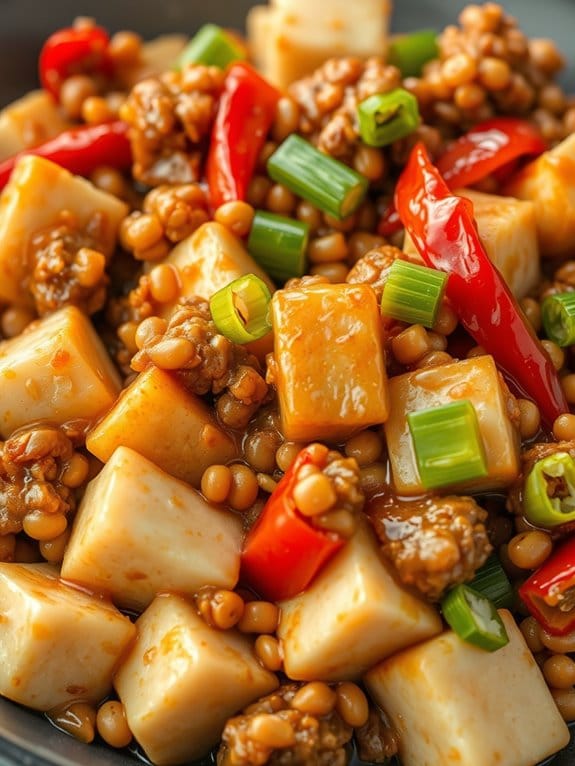
Guangdong Pork and Tofu Stir-Fry is a delightful and savory dish that brings the flavors of southern China to your dining table. This dish beautifully marries the taste of ground pork with the smooth texture of tofu, all enhanced by a blend of aromatic spices and sauces. Perfect for a weeknight dinner, this recipe isn’t only easy to prepare but also offers an authentic taste of Chinese cuisine that will impress your family and friends.
The combination of ground pork and tofu creates a nutritious and satisfying meal, while the addition of vegetables adds a vibrant color and freshness. It’s a wonderful way to incorporate protein and veggies into your diet without compromising on taste. The dish is typically served with steamed rice, making it a complete meal that’s both filling and flavorful. Gather your ingredients and follow this simple recipe to enjoy a taste of Guangdong in your home.
Ingredients (serves 4-6):
- 500g ground pork
- 400g firm tofu, diced into 1-inch cubes
- 2 tablespoons vegetable oil
- 3 cloves garlic, minced
- 1 tablespoon fresh ginger, minced
- 1 red bell pepper, sliced
- 1 green bell pepper, sliced
- 1 medium onion, sliced
- 3 tablespoons soy sauce
- 2 tablespoons oyster sauce
- 1 tablespoon Shaoxing wine (or dry sherry)
- 1 teaspoon sesame oil
- 1 teaspoon sugar
- 1/2 teaspoon white pepper
- 1 tablespoon cornstarch mixed with 2 tablespoons water
- 2 green onions, chopped for garnish
Cooking Instructions:
- Prepare the Tofu: Begin by pressing the tofu to remove excess water. Cut the tofu into 1-inch cubes and set aside.
- Stir-Fry the Pork: Heat 1 tablespoon of vegetable oil in a large skillet or wok over medium-high heat. Add the ground pork and cook, breaking it apart with a wooden spoon, until browned and cooked through. Remove the pork from the skillet and set aside.
- Cook the Aromatics and Vegetables: In the same skillet, add the remaining tablespoon of vegetable oil. Add the minced garlic and ginger, stirring continuously for about 30 seconds until fragrant. Then, add the sliced onion and bell peppers. Stir-fry the vegetables for about 3-4 minutes or until they start to soften.
- Combine Ingredients: Return the cooked pork to the skillet with the vegetables. Add the diced tofu, soy sauce, oyster sauce, Shaoxing wine, sesame oil, sugar, and white pepper. Stir everything together gently to avoid breaking the tofu cubes.
- Thicken the Sauce: Pour the cornstarch slurry (cornstarch mixed with water) into the skillet. Stir well to combine, allowing the sauce to thicken and coat the ingredients evenly. Cook for an additional 2-3 minutes.
- Finish and Serve: Turn off the heat and transfer the stir-fry to a serving dish. Garnish with chopped green onions and serve hot with steamed rice.
Extra Tips:
- For best results, use firm or extra-firm tofu to guarantee it holds its shape during cooking. Pressing the tofu beforehand will help it absorb the flavors better.
- Shaoxing wine adds an authentic depth of flavor, but if unavailable, dry sherry can be used as a substitute.
- Adjust the heat and add a touch of chili paste or fresh chili peppers if you prefer a spicier dish.
- Make sure to prepare all ingredients before starting to cook, as stir-frying is a quick process and requires constant attention.
Chongqing Spicy Pork Noodles

Chongqing Spicy Pork Noodles is a flavorful and vibrant dish that originates from Chongqing, a city known for its spicy and bold flavors. This dish combines the richness of ground pork with the spicy kick of Sichuan peppercorns and chili oil, all served over a bed of thick noodles.
It’s a perfect comfort food that brings together a symphony of flavors and textures, from the tender pork to the chewy noodles, and the numbing heat that makes this dish so addictive. Ideal for a family meal, this recipe serves 4-6 people and is sure to please anyone who enjoys spicy and savory dishes.
The preparation involves making a spicy pork topping, boiling the noodles, and assembling everything together with a generous amount of chili oil and fresh herbs. The result is a bowl of noodles that’s both satisfying and exciting to the palate.
Ingredients (Serves 4-6):
- 1 lb ground pork
- 1 package (14 oz) thick wheat noodles
- 3 tablespoons vegetable oil
- 2 tablespoons Sichuan peppercorns
- 4 cloves garlic, minced
- 1-inch piece ginger, minced
- 2 tablespoons doubanjiang (fermented bean paste)
- 1 tablespoon soy sauce
- 2 tablespoons Chinese black vinegar
- 1 tablespoon sugar
- 1 cup chicken broth
- 1/2 cup chili oil
- 4 green onions, chopped
- 1/2 cup fresh cilantro, chopped
- Salt to taste
Cooking Instructions:
- Prepare the Pork Topping:
- Heat the vegetable oil in a large skillet over medium heat. Add the Sichuan peppercorns and toast them until aromatic, about 2 minutes. Remove the peppercorns and set aside.
- In the same oil, add the minced garlic and ginger and sauté until fragrant. Increase the heat to medium-high and add the ground pork. Cook, breaking it up with a spatula, until browned and cooked through.
- Flavor the Pork:
- Stir in the doubanjiang, soy sauce, black vinegar, and sugar. Mix well to combine all the ingredients. Cook for another 2-3 minutes until the pork is well-coated with the sauce.
- Pour in the chicken broth and let it simmer for 5 minutes, allowing the flavors to meld together. Adjust seasoning with salt if necessary.
- Cook the Noodles:
- While the pork is simmering, bring a large pot of water to a boil. Add the thick wheat noodles and cook according to package instructions until al dente. Drain and rinse under cold water to stop the cooking process.
- Assemble the Dish:
- Divide the cooked noodles among serving bowls. Top each bowl with a generous portion of the spicy pork mixture.
- Drizzle with chili oil and sprinkle with the toasted Sichuan peppercorns. Garnish with chopped green onions and cilantro.
- Serve:
- Mix everything together in each bowl before eating to guarantee the noodles are well-coated with the spicy, savory sauce.
Extra Tips:
- Adjust the level of chili oil according to your spice tolerance. Start with a smaller amount and add more if you prefer a spicier dish.
- For a more authentic flavor, try using fresh Sichuan peppercorns if available, as they provide a unique numbing sensation alongside the heat.
- Doubanjiang can vary in saltiness, so taste the pork mixture before adding additional salt to avoid over-seasoning.
- If you prefer a vegetarian version, substitute the ground pork with crumbled tofu or mushrooms for a similar texture and taste.
Jiangsu Sweet and Sour Pork

Jiangsu Sweet and Sour Pork is a classic dish that originates from the Jiangsu province in China, known for its balanced flavors and appealing presentation. This dish is characterized by tender pieces of pork that are coated in a crispy batter and then tossed in a vibrant sweet and sour sauce. The sauce’s balance of sweetness and tanginess complements the savory notes of the pork, creating a harmonious and delightful culinary experience that’s both satisfying and memorable.
Whether served as a main dish for a family dinner or as a centerpiece for a festive occasion, Jiangsu Sweet and Sour Pork brings a touch of authentic Chinese cuisine to your table.
The hallmark of this dish is its ability to combine contrasting flavors and textures seamlessly. The pork is typically marinated to guarantee it remains juicy and flavorful, then coated in a light batter that crisps to perfection when fried. The sauce, often a rich blend of vinegar, sugar, and soy sauce, envelops the pork in a glossy finish that’s both visually appealing and delicious.
By following this recipe, you can recreate the authentic taste of Jiangsu Sweet and Sour Pork, bringing the essence of Chinese culinary artistry into your own kitchen.
Ingredients (Serves 4-6):
- 500g ground pork
- 1 egg
- 2 tablespoons cornstarch
- 1 tablespoon soy sauce
- 1 tablespoon rice vinegar
- 3 tablespoons sugar
- 1/2 cup ketchup
- 1/2 cup pineapple juice
- 1 red bell pepper, diced
- 1 green bell pepper, diced
- 1 onion, diced
- 2 cloves garlic, minced
- 1 tablespoon ginger, minced
- Vegetable oil for frying
- Salt and pepper to taste
- 1 tablespoon sesame oil
- 1 tablespoon sesame seeds
- 2 spring onions, finely chopped
Instructions:
- Prepare the Pork: In a large mixing bowl, combine the ground pork, egg, 1 tablespoon of cornstarch, soy sauce, and a pinch of salt and pepper. Mix well until fully combined. Form the mixture into small balls or patties, depending on your preference, and set aside.
- Make the Sauce: In a separate bowl, combine the rice vinegar, sugar, ketchup, pineapple juice, and 1 tablespoon of cornstarch. Stir until the sugar and cornstarch are fully dissolved, creating a smooth sauce. Set aside.
- Cook the Vegetables: Heat a tablespoon of vegetable oil in a large pan over medium heat. Add the diced onion, red bell pepper, green bell pepper, garlic, and ginger. Sauté for about 5 minutes until the vegetables are tender and fragrant. Remove from the pan and set aside.
- Fry the Pork: In the same pan, add enough vegetable oil to cover the base and heat over medium-high heat. Once hot, carefully add the prepared pork balls or patties. Fry them until golden brown and cooked through, about 5-7 minutes. Remove from the pan and drain on paper towels.
- Combine and Cook: Pour the sweet and sour sauce into the pan and bring to a gentle boil. Add the cooked vegetables and pork back into the pan, stirring to coat everything evenly in the sauce. Allow the mixture to cook for an additional 5 minutes, letting the flavors meld together.
- Finish and Serve: Drizzle the sesame oil over the dish and sprinkle with sesame seeds and chopped spring onions before serving. Serve hot over a bed of steamed rice or alongside your favorite Chinese side dishes.
Extra Tips:
For a more authentic experience, consider using Chinese black vinegar instead of regular rice vinegar for a deeper flavor profile. Additionally, adjusting the sugar and vinegar levels in the sauce can help you achieve your preferred balance of sweetness and tanginess.
Guarantee the pork balls are evenly sized for uniform cooking, and avoid overcrowding the pan when frying to maintain the desired crispiness. Finally, using fresh pineapple juice (instead of canned) can enhance the overall freshness and natural sweetness of the dish.
Hakka Stuffed Tofu With Pork
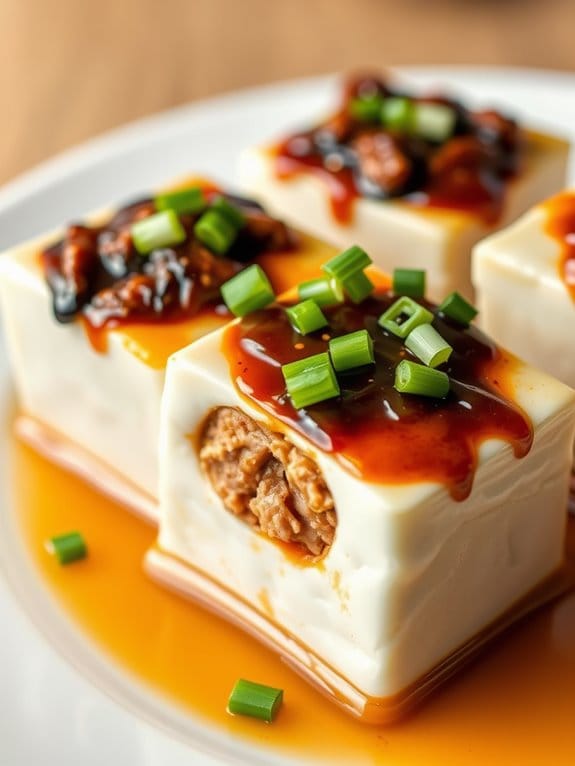
Hakka Stuffed Tofu With Pork is a delicious and savory dish that originates from the Hakka Chinese community. This dish is characterized by its flavorful ground pork filling that’s stuffed into blocks of tofu, creating a delightful blend of textures and tastes. The pork filling, seasoned with a mixture of soy sauce, ginger, and garlic, perfectly complements the soft and silky tofu.
It’s a popular comfort food that’s both nutritious and satisfying, often enjoyed at family gatherings or as a hearty dinner option. In this recipe, the tofu acts as a neutral canvas that absorbs the rich flavors of the marinated pork and the accompanying sauce. The dish is usually steamed, allowing the flavors to meld together and the tofu to gently absorb the savory juices.
The result is a tender and flavorful bite that’s both comforting and nourishing. The simplicity of the dish belies the complex flavors that develop through the cooking process, making it a favorite among those who appreciate authentic Chinese cuisine.
Ingredients for 4-6 servings:
- 400 grams of ground pork
- 6 blocks of firm tofu
- 2 tablespoons of soy sauce
- 1 tablespoon of oyster sauce
- 1 teaspoon of sesame oil
- 2 cloves of garlic, minced
- 1 tablespoon of grated ginger
- 1 stalk of spring onion, finely chopped
- 1 egg
- Salt and pepper to taste
- Cornstarch (for binding)
- 1 cup of chicken stock
Cooking Instructions:
- Prepare the Tofu: Carefully cut each block of tofu in half horizontally, creating two thinner blocks. Using a spoon, gently scoop out a small portion of the center of each block to create a hollow space for the filling. Be cautious not to break the tofu.
- Make the Pork Filling: In a large bowl, combine the ground pork, soy sauce, oyster sauce, sesame oil, minced garlic, grated ginger, chopped spring onion, and egg. Add a pinch of salt and pepper. Mix well until all ingredients are thoroughly combined. If the mixture feels too wet, add a little cornstarch to help bind it.
- Stuff the Tofu: Fill the hollowed centers of the tofu blocks generously with the pork mixture, pressing down gently to guarantee the filling stays in place.
- Steam the Tofu: Arrange the stuffed tofu blocks in a steamer basket. Bring water to a boil in a pot, then place the steamer basket over the pot. Cover and steam the tofu for about 20-25 minutes, or until the pork is cooked through and the tofu is heated.
- Prepare the Sauce: While the tofu is steaming, heat the chicken stock in a small saucepan. Adjust the seasoning with soy sauce or salt if needed. Once the tofu is done, you can pour some of this broth over the stuffed tofu before serving.
- Serve: Carefully remove the steamed tofu from the steamer and place them on a serving platter. Pour the sauce over the top, and garnish with extra chopped spring onions if desired. Serve hot.
Extra Tips:
When preparing Hakka Stuffed Tofu with Pork, make certain that the tofu you select is firm, as it will hold the stuffing better during cooking. If you prefer a bit of spice, you can add a dash of chili flakes to the pork mixture.
Additionally, when steaming, make sure the water level isn’t too high; it shouldn’t touch the tofu. This guarantees the tofu steams evenly without becoming soggy. For a more robust flavor, consider marinating the pork mixture for about 30 minutes before stuffing the tofu. This will allow the flavors to deepen and enrich the overall taste of the dish.

